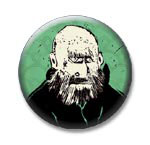On The Way: The Daily Zen Journal
Bodhidharma’s Breakthrough Sermon
Bodhidharma (440-528)
If someone is determined to reach enlightenment, what is the most essential method one can practice?
The most essential method, which includes all methods, is beholding the mind.
But how can one method include all others?
The mind is the root from which all things grow. If you can understand the mind, everything else is included. It’s like a tree. All of its fruit and flowers, its branches and leaves, depend on its root. If you nourish its root, a tree multiplies. If you cut its root, it dies.
Those who understand the mind reach enlightenment with minimal effort. Those who don’t understand the mind practice in vain. Everything good and bad comes from your own mind. To find something beyond the mind is impossible.
But how can beholding the mind be called understanding?
When a great bodhisattva delves deeply into perfect wisdom, he realizes that the four elements and five shades are devoid of a personal self. And he realizes that the activity of his mind has two aspects: pure and impure.
By their very nature, these two mental states are always present. They alternate as cause or effect depending on conditions, the pure mind delighting in good deeds, the impure mind thinking of evil.
Those who are not affected by impurity are sages. They transcend suffering and experience the bliss of nirvana. All others, trapped by the impure mind and entangled by their own karma, are mortals. They drift through the three realms and suffer countless afflictions. And all because this impure mind obscures their real self.
The Sutra of the Ten Stages says, “In the body of mortals is the indestructible buddha-nature. Like the sun, its light fills endless space. But once veiled by the dark clouds of the five shades, it’s like a light inside a jar hidden from  view.”
view.”
And the Nirvana Sutra says, all mortals have the buddha-nature. But it is covered by darkness from which they can not escape. Our buddha-nature is awareness: to be aware and to make others aware. To realize awareness is liberation.” Everything good has awareness for its root. From this root of awareness grows the tree of all virtues and the fruit of nirvana. Beholding the mind like this is understanding.
The mind is the source of all virtues. And this mind is the chief of all powers. The eternal bliss of nirvana comes from the mind at rest. Rebirth in the three realms also comes from the mind. The mind is the door to every world. And the mind is the ford to the other shore.
Those who know where the door is do not worry about reaching it. Those who know where the ford is don’t worry about crossing it. The people I meet nowadays are superficial. They think of merit as something that has form.
They foolishly concern themselves with erecting statues and stupas, telling people to pile up lumber and bricks, to paint this blue and that green. They strain body and mind, injure themselves and mislead others. How will they ever become enlightened? They see something tangible and instantly become attached. If you talk to them about formlessness, they sit there dumb and confused. Such disciples wear themselves out in vain.
If you can simply concentrate your mind’s inner light and behold its outer illumination, you’ll dispel the three poisons and drive away the six thieves once and for all. And without effort you will gain possession of an infinite number of virtues, perfections and doors to the truth.
Seeing through the mundane and witnessing the sublime is less than an eye-blink away. Realization is now. Why worry about gray hair? The true door is hidden and can’t be revealed. I have only touched upon beholding the mind.
Bodhidharma (440-528)
Excerpted from The Zen Teaching of Bodhidharma trans by Red Pine
Buddhism came to China 2000 years ago. Among those who brought the teachings of the Buddha to China, none has had the impact of Bodhidharma. Unknown to all but a few disciples in his own lifetime, Bodhidharma is the patriarch of millions of Zen Buddhist and students of kung-fu. He’s also the subject of many legends.
Along with Zen and kung-fu, Bodhidharma also brought tea to China. To keep from falling asleep while meditating, he cut off his eyelids, and where they fell, tea bushes grew. Since then, tea has become the beverage of not only monks but everyone in the Orient. Faithful to this tradition, artists invariably depict Bodhidharma with bulging, lidless eyes.




This teaching of Bodhidharma’s is a kind of bare bones approach to practice, a nothing extra direct experience. Nothing extra is a term we hear in practice which represents both movement with no added tension and ideally a minimal sense of self to interfere with unhindered, spontaneous expression.
Each journal piece aims to provide a word or sentence to reflect on and go more deeply into. Sometimes it will be clear, other times it is like a koan in itself as to how to implement the teacher’s message.
What from Bodhidharma speaks to you this time? Perhaps several readings will provide more clues.
The most essential method, which includes all methods, is beholding the mind.
Returning to the Source,
Elana, Scribe for Daily Zen